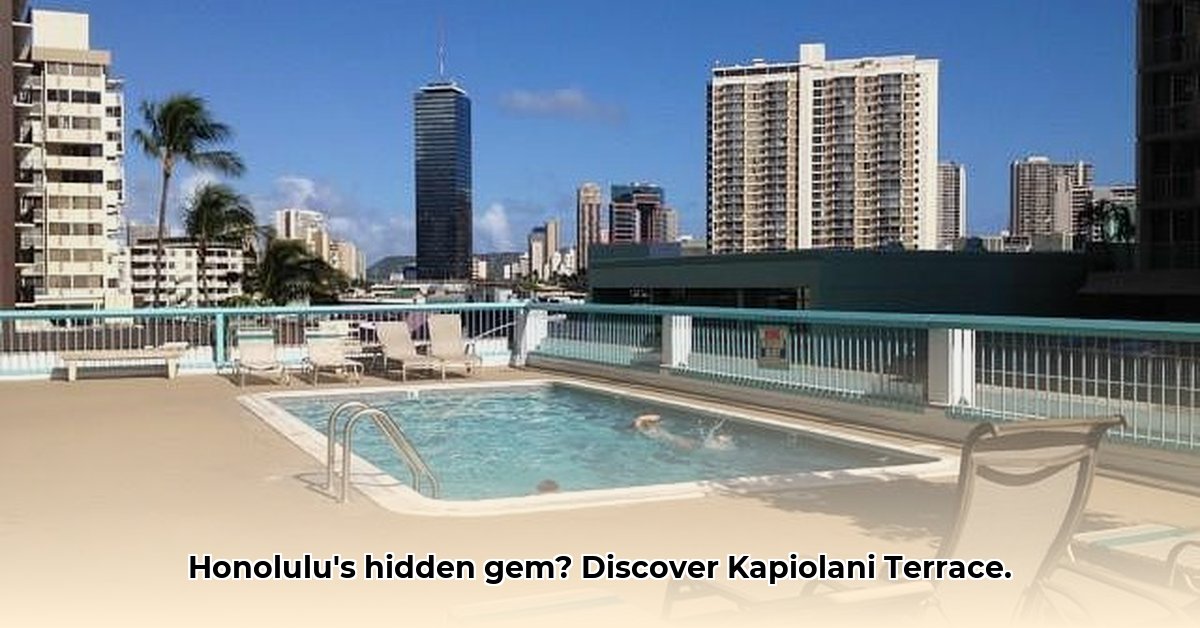
Kapiolani Terrace offers a compelling blend of prime location and investment potential in Honolulu's vibrant Ala Moana-Kakaako neighborhood. This 17-story building presents a unique opportunity for buyers and investors alike, although careful consideration of its strengths and weaknesses is crucial. Let's delve into the details.
Location and Amenities: Unbeatable Honolulu Access
Kapiolani Terrace boasts an enviable location, earning a Walk Score of 94 – a testament to its unparalleled proximity to Honolulu's best attractions. Imagine strolling to Ala Moana Center for shopping, enjoying leisurely walks along Ala Moana Beach Park, or easily accessing a diverse array of restaurants and entertainment venues. This exceptional walkability significantly reduces reliance on a vehicle, a major advantage in Honolulu's often congested traffic environment. The building itself offers amenities such as a pool and secured parking, adding to its appeal.
Unit Breakdown: A Niche Market Opportunity
The building's composition is noteworthy: approximately 88% of its 266 units comprise studios and one-bedroom apartments. While this might limit appeal to larger families, it simultaneously creates a highly targeted and potentially lucrative niche market, particularly for investors focusing on the strong demand for smaller rental units in Honolulu. This concentration of studios and one-bedrooms caters directly to the substantial population of single professionals and couples seeking convenient city living.
Pros and Cons: A Balanced Perspective
As with any real estate investment, it's vital to weigh the advantages and disadvantages before making a decision.
Pros:
- Exceptional Location: Unparalleled walkability and proximity to Ala Moana Center, Ala Moana Beach Park, and a wealth of amenities.
- High Rental Demand: The prevalence of studios and one-bedroom units translates to strong rental demand, making it particularly attractive for investors.
- Vibrant Neighborhood: Residents enjoy easy access to shopping, dining, entertainment, and recreational activities.
Cons:
- Limited Lanai Space: Many units lack lanais (balconies or patios), potentially a significant drawback for those seeking outdoor living space.
- Smaller Unit Sizes: The emphasis on smaller units may not suit larger families or those requiring extensive living areas.
- Building Age: As a building constructed in 1973, potential buyers should anticipate increased maintenance needs and costs compared to newer constructions.
- Potential Pet Restrictions: Prospective pet owners should inquire about the building's pet policies.
Investment Potential: Analyzing the Returns
The strong rental demand fueled by the high concentration of studios and one-bedrooms suggests significant investment potential for Kapiolani Terrace. However, prospective investors need to conduct thorough due diligence, including a detailed analysis of vacancy rates, operating expenses (HOA fees, property taxes, etc.), and comparable rental incomes in the area. While the desirable location typically ensures high occupancy, the building's age and potential need for maintenance should factor into long-term cost projections. Careful research into rental trends and property value appreciation is crucial before making any investment commitments.
Buyer Considerations: The Ideal Resident Profile
Kapiolani Terrace is best suited for specific buyer profiles. Single professionals, couples, and smaller families who prioritize location, walkability, and a vibrant urban lifestyle will find this condo complex ideal. The smaller unit sizes make it less suitable for larger families seeking ample living space. The lack of lanais in many units is another factor to consider.
Conclusion: A Calculated Investment Decision
Kapiolani Terrace in Honolulu represents a strong investment opportunity, particularly for those targeting the substantial demand for smaller rental units. Its prime location and high Walk Score are undeniable assets. However, potential buyers and investors must carefully evaluate the building's age, the limitations of the predominantly small unit sizes, and the absence of lanais in many units. A thorough market analysis, including a comprehensive assessment of rental income, maintenance costs, and the broader Honolulu real estate market, is crucial for making a well-informed decision. Consulting with real estate professionals is highly recommended.